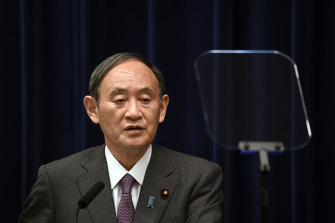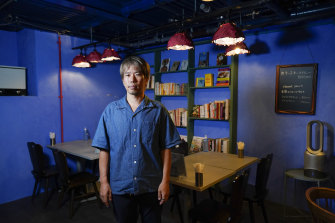It took an Olympics without spectators, four states of emergency, and the resignation of a prime minister, but after four months, Japan has crushed its sharpest coronavirus wave yet.
A fortnight after the Olympic flame went out in Tokyo on August 8, Japan recorded more than 25,000 cases. On Friday, the country added under 400 and Tokyo just 26.
The result is a remarkable turnaround for a city where residents and businesses had sometimes flaunted the government’s restrictions. It’s also noteworthy for a country where the top doctors feared its medical system was on the brink of collapse.

Keisuke Yamamoto of Jeremiah Tokyo at his bar in Tokyo’s Shinjuku district. Credit:Christopher Jue
Next week Tokyo’s restaurants are expected to be released from some of the last restrictions that have stopped them from operating at full capacity, the final hangovers from its last state of emergency.
Their relief is not the result of any one factor, but because many elements including vigilance, fear, luck and vaccines came together to subdue a disease that has killed more than 18,000 Japanese people.
Viriologist Hitoshi Oshitani, the architect of Japan’s early response to COVID-19, said while the Olympics built some frustration among fans who could not participate in the Games, that resentment was soon trumped by fear and a sense of civic duty when cases started reaching more than 15000 a day halfway through the Olympics.
At its peak, deaths reached 90 per day. More than 20 Tokyo residents died at home during this period, including four cases in their 30s, four in their 40s, nine in their 50s because the hospitals were too stretched to handle the caseload and ambulances were forced to hop between emergency rooms searching for a bed.
“Once they saw the news about the situation in hospitals and deaths at home, this information had an impact in terms of behaviour change,” said Oshitani. “The effect of this information is quite significant in Japanese society. It creates a strong sense of peer pressure.”
Face masks, which have high rates of use in health-conscious Japan outside a pandemic, were also a factor in limiting transmission. So was the fortunate timing of the peak of its wave.
Summer in Japan, particularly in Tokyo, is hot, very hot. The 30 degree plus temperatures in one of the densest cities in the world mean people are often inside, with air-conditioning on but no windows open.
“But September is quite pleasant,” said Oshitani “It’s cooler, but you can open the window and the dining out is better.”
The same pattern occurred in Japan last year. Cases fell when there was less opportunity for indoor transmission and September and October are quieter months on the Japanese event calendar. There are fewer drinking opportunities or gatherings with the extended family over festivals like Obon in mid-August.
“Every time we have a long holiday we see an increase in cases,” said Oshitani, who worries they will pick up again once the end-of-year bonenkai party season starts in December and winter forces revellers indoors again.
After a sluggish start - Japan’s vaccine rollout escalated sharply from August onwards, particularly among those aged under 60 - who while less likely to get severely ill, are more likely to account for the majority of cases because they are travelling and mixing with family and friends.
The timing meant that 60 per cent of the population was fully vaccinated by the end of September, giving them maximum resistance to the disease at its peak and triggering a fall in cases. The lower numbers are not the result of fewer tests, the share of tests coming back positive has plummeted from 10 per cent in Tokyo in July to 0.6 per cent on Friday.
“This outbreak was also much bigger than the previous ones,” said Oshitani. “Officially during this outbreak in Tokyo, about 3 per cent of the people aged 20 to 29 years were identified as confirmed cases. But the real number is probably three or four times higher than that, which means, probably more than 10 per cent of young people were infected, and now they still have immunity from the natural infection.”
Japan, it seems, is in a sweet spot. Caught between the seasons, restrictions and vaccinations, the COVID-19 wave eventually had to crash.

Former Japanese prime minister Yoshihide SugaCredit:AP
Unfortunately, for former prime minister Yoshihide Suga it did not come soon enough. The 72-year-old resigned as leader of his party in September after his approval ratings fell into the 30s over his leadership style, handling of COVID-19 and the Olympics.
“It was unlucky for him,” said Sota Kato from the Tokyo Foundation for Policy Research. “Even if he remained as prime minister he could not win the Liberal Democratic Party election at that time.”
The baton now falls to his replacement as LDP leader, Fumio Kishida, who will take Japan to the polls on October 31. “I think it will have a positive effect for the LDP,” said Kato.
Despite the newfound optimism in Japan, there is a warning for Australia and other countries around the world who started their vaccine campaign late and are now reaching high levels of coverage. The experience overseas may require them to re-write the timetable for their booster programs as they open up.
“Waning of immunity is becoming a major issue,” said Oshitani, who said Japan had already started noticing the vaccines waning after three months in the elderly who received their jabs first - not the six months that has been flagged for most booster programs.
Japan is the world’s fastest ageing country, with 29 per cent of its population aged over 65. Its medical experts are acutely aware of the impact of COVID-19 developments among its older residents.
“In Japan, we are starting to see the same with more breakthrough infections among the elderly,” said Oshitani.
Oshitani speaks regularly with his colleagues in the region. On Thursday, he talked to Singapore’s National Centre for Infectious Disease. The city-state is seeing cases rising by 3000 per day despite 85 per cent of residents being fully vaccinated. Many of its older residents were fully vaccinated by May.
“They clearly show that waning of immunity is probably the major factor,” he said.
“That’s probably why they are seeing the increasing number there and in the United Kingdom. Even with high vaccine coverage, the effectiveness is waning around three months after the second dose of vaccination.”

Yohei Matsuzaki, the owner of Have More Curry in Tokyo’s Shibuya. Credit:Christopher Jue
Businesses are feeling battered and sceptical. Keisuke Yamamoto, the owner of speakeasy bar Jeremiah Tokyo said he was looking forward to restrictions easing. “But I think many people are scared to go out,” he said.
Yohei Matsuzaki, who runs the Have More Curry restaurant in Shibuya said he was surprised by the sharp drop in numbers.
“Winter is coming soon, so there could be another wave,” he said. “I wouldn’t be surprised if the same state of emergency cycle takes place again.”
With Christopher Jue
Get a note direct from our foreign correspondents on what’s making headlines around the world. Sign up for the weekly What in the World newsletter here.
Most Viewed in World
https://news.google.com/__i/rss/rd/articles/CBMidWh0dHBzOi8vd3d3LnNtaC5jb20uYXUvd29ybGQvYXNpYS9ob3ctamFwYW4taGl0LXRoZS1zd2VldC1zcG90LXRvLWNydXNoLXRoZS1sYXRlc3Qtd2F2ZS1vZi1jb3ZpZC0yMDIxMTAyMC1wNTkxbmIuaHRtbNIBAA?oc=5
2021-10-23 18:00:00Z
CAIiEESTcqjyMJMQ9RkkcY2F_JgqGQgEKhAIACoHCAowxqmICzDg_IYDMPbfmwY
Bagikan Berita Ini















0 Response to "How Japan hit the sweet spot to crush the latest wave of COVID - Sydney Morning Herald"
Post a Comment